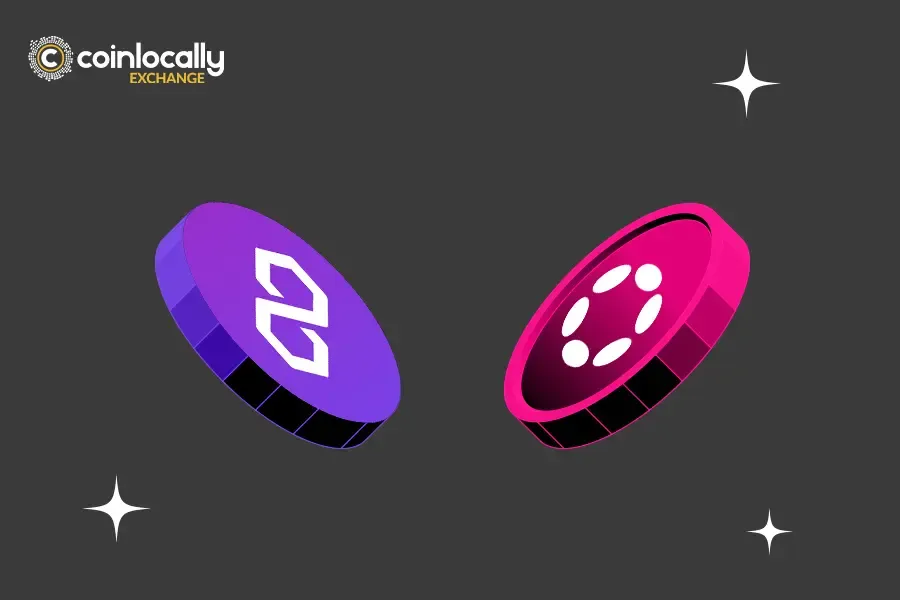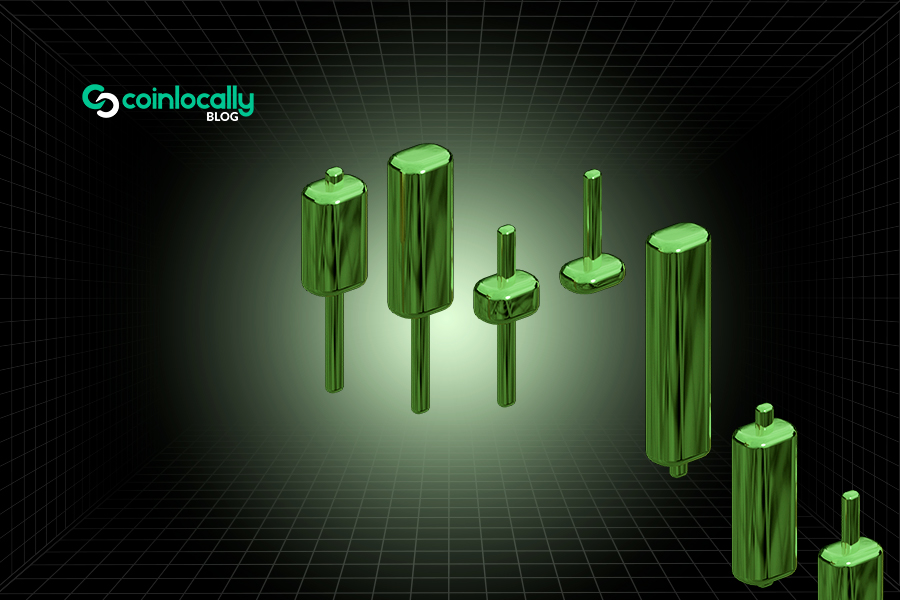Many crypto platforms claim to be the next generation, but Polygon and Polkadot are the most famous. To choose one of them as a better investment, we must compare Polygon vs. Polkadot and learn about each project’s features.
Table of Contents
What Is a Polygon?
Polygon (first known as Matic Network) is designed as a Layer 2 scaling solution for Ethereum, which aims to increase transaction speed and decrease fees while keeping the Ethereum network secure and decentralized.
To this aim, Polygon uses sidechains, which are independent blockchains developed to connect with the Ethereum main chain to carry out some tasks.
The Polygon platform is a go-to place for many dApps (decentralized applications) developers as it provides Ethereum’s security level but with remarkably faster transactions and lower fees since Polygon is not as congested as the Ethereum network.
Also, Polygon supports the Ethereum Virtual Machine (EVM), which lets existing Ethereum dApps be ported over to the Polygon network, which gives Polygon special features, including more efficiency and accessibility.
Polygon Features
- High Scalability: Polygon uses a Layer 2 scaling solution to process thousands of transactions per second, making it a highly scalable platform.
- Low Transaction Fees: Polygon charges significantly lower fees than Ethereum, which makes it more accessible to users.
- Fast Confirmation Times: Polygon confirms transactions within seconds.
- Ethereum Compatibility: Polygon is entirely compatible with Ethereum, allowing the current Ethereum dApps to be easily migrated to Polygon.
- Interoperability: Polygon communicates with other blockchains to provide seamless cross-chain transfers of assets and data.
- Developer-Friendliness: Polygon provides various tooling, documentation, and support to streamline building and deploying dApps for developers.
- Ecosystem Growth: Polygon’s ecosystem of dApps, projects, and partnerships enables consistevelopment.
Welkadot, we need to learn about the Polkadot network and compare Polygon vs. Polkadot’s features.
What Is Polkadot?
Polkadot aims to be a next-generation blockchain platform that provides more interconnectedness, scalability, and interoperability in the blockchain. Polkadot uses the experience of its founder, Gavin Wood, who has also co-founded Ethereum.
Polkadot’s multi-chain architecture lets different blockchains connect and cooperate, making it a suitable platform for building and deploying dApps that perform across various blockchains and networks.
Polkadot has a main relay chain that harmonizes connections between different para-chains, which are independent blockchains connected to the relay chain.
Para-chains are helpful as they have various use cases or applications in smart contracts, DeFi, gaming, identification, etc.
Also, Polkadot’s governance system is fully decentralized as it lets token holders vote for upcoming changes, from adding new para-chains to upgrading the protocol.
The Lkadot platform is built on Substrate, a blockchain infrastructure for developers to develop and deploy custom applications.
It means that using Polkadot, developers can launch their own blockchain project.
Polkadot Features
- Multi-Chain Architecture: Using Polkadot, a multi-chain architecture enables Polkadot to connect various blockchains and provide cross-chain interoperability and scalability.
- Cross-Chain Transactions: On Polkadot, users can transfer assets and data among blockchains.
- Shared Security: Polkadot’s para-chains can share security resources offered by the main relay chain to increase security and resist attacks.
- Scalability: Thanks to Polkadot’s multi-chain architecture, users can expect high transaction throughput and scalability, allowing large-scale dApps creation.
- Governance: Polkadot supports community-driven decision-making and lets the holders of the DOT token (Polkadot’s native cryptocurrency) vote for changes.
- Interoperability: Polkadot is a multi-chain, enabling cross-chain transactions, meaning it is highly interconnected and interoperable.
- Customizability: Substrate, a blockchain development structure on which Polkadot is built, streamlines the customization and deployment of blockchain applications.
Now that we know the backbones of both projects, it’s time to compare Polygon and Polkadot to see which better fits our cryptocurrency portfolio. Let’s start with their key differences.
The Key Differences Between Polygon vs. Polkadot
The following table summarizes the key differences between Polygon and Polkadot, focusing on their creators, launch date, consensus algorithm, block time, transaction throughput, and supply.
Other factors affecting our decision about investing in Polygon vs. Polkadot are as follows:
- Price History
- ROI, ATL, ATH,
- Consensus Mechanism,
- Architecture,
- The Latest Developments,
- NFT,
- Fees,
- Transaction Speed,
- Price Prediction,
- DeFi, and
- Staking.
Polygon vs. Polkadot: Price History
- Polygon (MATIC) started trading on April 27, 2019, at $0.00547046.
- Polkadot (DOT) started trading on August 19, 2020, at $2.94.
- Polygon’s lowest trading price was $0.00314376, less than a month after its launch on May 10, 2019.
- Polkadot fell to its lowest trading price of $2.70 just a few months after its launch on August 20, 2020.
- Polygon struggled in the $0.0055429 range for about two years and finally started to move upward on March 14, 2021, at $0.422974.
- Polkadot fluctuated in the $6 range for about four months and then started the upward trend at $6.61 on December 29, 2020.
- Polygon continued the uptrend and reached $2.45 on May 19, 2021.
- Polkadot continued the uptrend and reached $47.33 on May 15, 2021.
- Polygon (MATIC) experienced some ups and downs in the following six months and finally recorded its highest trading price of $2.92 on December 27, 2021.
- Polkadot (DOT) experienced some ups and downs in the following six months and finally recorded its highest trading price of $54.98 on November 04, 2021.
- Polygon went down in the next six months after its highest price level and reached $0.382169 on June 20, 2022.
- Polkadot went on a downtrend in the next six months after its highest price level and reached $7.50 on June 20, 2022.
- Polkadot experienced downtrends and small fluctuations during 2023 and 2024 and revolved around $5-6.
- Polygon experienced more fluctuations but in a lower range of about $0.50-0.70.
- On November 19, 2024, each MATIC is traded at $0.4445.
- Today, on November 19, 2024, each DOT is traded at $5.93.
Although price history generalizes a cryptocurrency’s financial performance since its launch, it’s not the only crucial monetary factor. We generalize vs. Polkadot regarding ROI, ATL, and ATH.
Polygon vs. Polkadot: ROI, ATL, and ATH
ROI (Return on Investment) shows the profitability of a given cryptocurrency over specific periods. It is shown in positive and negative numbers, with negative numbers indicating investment loss.
The following table indicates Polygon vs. Polkadot ROI for the total recent year, month, week, and 24 hours.
| ROI | Polygon | Polkadot |
| Total | +9701.96% | +113.13% |
| Yearly | -46.10% | +13.73% |
| Monthly | +19.89% | +34.23% |
| Weekly | +12.37% | +10.94% |
| Daily | +5.61% | +3.36% |
As the table above shows, Polygon (MATIC)has experienced a more significant price growth since its launch, but in a lower range than Polkadot (DOT).
Two other important financial factors are All-Time Low (ATL) and All-Time High (ATH), which show a given cryptocurrency’s lowest and highest trading price until today.
The table below shows the ATL and ATH of Polygon vs. Polkadot, plus their differences compared to their tokens’ current price levels, to help you understand each token’s potential.
| Polygon vs. Polkadot | Polygon | Polkadot |
| ATL | $ 0.003144 on May 10, 2019 | $ 2.70 on August 20, 2020 |
| ATH | $ 2.92 on December 27, 2021 | $54.98 89.3%on Nov 04, 2021 |
| Current Price (November 19, 2024) | $0.4445(13999.1% higher than its ATL but 84.8% lower than its ATH) | $5.93(118.2% higher than its ATL but 89.3% lower than its ATH) |
Polygon vs. Polkadot: Consensus Mechanism
Polygon, therefore, utilizes a Proof-of-Stake (PoS) consensus mechanism. In this system, validators are selected based on the quantity of tokens they possess and are willing to stake as collateral. This approach enhances security and encourages participants to act in the network’s best interest.
Validators validate transactions, add new blocks to the blockchain, and are rewarded with a portion of transaction fees and the platform’s native tokens.
PoS is more energy-efficient than Proof-of-Work (PoW).
Polkadot’s hybrid consensus algorithm combines the elements of PoS and PoA and is known as GRANDPA (GHOST-based Recursive Ancestor Deriving Prefix Agreement).
Like Polygon’s consensus mechanism, Polkadot’s validators are selected according to the number of tokens they hold and want to stake. Validators must add new blocks and validate transactions.
However, Polkdot differs from Polygon because it uses a secondary mechanism called BABE (Blind Assignment for Blockchain Extension) to avoid network forking and ensure quick finality.
BABE is a PoA consensus algorithm that selects validators randomly. Also, BABE ensures fast block addition and high finality, making transactions irreversible after being added to a block.
Polygon vs. Polkadot: Architecture
The following image compares Polygon vs. Polkadot regarding architecture.
Generally, while Polygon’s architecture prioritizes providing a Layer 2 scaling solution for Ethereum, Polkadot’s architecture is designed to increase the interoperability among various blockchains, making it a better platform for developing complex dApps that require connectivity between different systems.
Polygon vs. Polkadot: NFT
Polygon and Polkadot are home to Non-Fungible Tokens (NFTs). In the following table, compare their current status regarding NFTs.
Polygon vs. Polkadot: Fees
Transaction fees vary based on demand (network congestion) and activity level. Therefore, understanding how these factors influence costs is essential. Specifically, this is how Polygon and Polkadot adjust their transaction fees accordingly.
- Built on top of the Ethereum blockchain, Polygon uses Ethereum’s fee model, which depends on gas fees paid by users to execute smart contracts and transactions on the network. However, as Polygon is not as congested as the Ethereum network, it charges significantly lower gas fees than the Ethereum mainnet.
- Instead of gas fees, Polkadot charges transaction fees in its native DOT cryptocurrency, which secures the network and incentivizes validators.
Polygon vs. Polkadot: Transaction Speed
- Polygon’s Layer 2 solutions (Optimistic Rollups and ZK Rollups) can process up to 7,000 Transactions Per Second (TPS), which is remarkably higher than Ethereum’s current throughput, i.e., about 15 TPS.
- Thanks to its sharded architecture and GRANDPA consensus mechanism, Polkadot enables parallel processing of transactions across multiple shards, i.e., up to 100,000 TPS.
Polygon vs. Polkadot: Price Prediction
While price predictions are not 100% correct, it’s good to know how market experts think about a cryptocurrency’s future. The following table displays a general price prediction of Polygon vs. Polkadot from 2025 to 2030.
| Year | Coin | Min. Price | Ave. Price | Max. Price |
| 2025 | Polygon | $0.6086 | $0.6300 | $0.7173 |
| Polkadot | $6.25 | $6.47 | $7.59 | |
| 2026 | Polygon | $0.8901 | $0.9153 | $1.06 |
| Polkadot | $8.64 | $8.96 | $10.90 | |
| 2027 | Polygon | $1.25 | $1.29 | $1.50 |
| Polkadot | $12.16 | $12.52 | $14.83 | |
| 2028 | Polygon | $1.81 | $1.88 | $2.19 |
| Polkadot | $18.05 | $18.55 | $20.85 | |
| 2029 | Polygon | $2.66 | $2.75 | $3.15 |
| Polkadot | $26.03 | $26.95 | $30.43 | |
| 2030 | Polygon | $3.86 | $4.00 | $4.63 |
| Polkadot | $38.58 | $39.93 | $45.80 |
Polygon vs. Polkadot: DeFi
- Polygon is a leading DeFi platform primarily because of its fast and affordable transactions. Furthermore, numerous popular DeFi protocols, such as Aave, Curve, and SushiSwap, have integrated with Polygon, highlighting its growing significance in the decentralized finance space.
- Because of its interoperability features, Polkadot is a suitable platform for DeFi applications needing connectivity between different blockchains. Some DeFi projects on Polkadot are Acala, Moonbeam, and ChainX.
Polygon vs. Polkadot: Staking
Both Polygon and Polkadot allow staking on their platforms. Here’s how their staking systems work.
Polygon Staking
- Polygon employs posDAO as its staking mechanism; consequently, this allows users to delegate their tokens to validators that secure the network and process transactions. As a result, users can contribute to the network’s security while potentially earning rewards for their staked tokens.
- Stakers earn rewards as MATIC tokens.
- Polygon’s staking rewards can range from 5% to 20%.
Polkadot Staking
- Polkadot also uses a PoS consensus mechanism, letting users stake DOT tokens to help secure the network and earn rewards.
- Polkadot’s staking mechanism is called Nominated Proof of Stake (NPoS), by which users select validators to secure the network and process transactions.
- Stakers are rewarded with DOT tokens.
- Polkadot’s staking rewards can range from 5% to 15%.
Polygon vs. Polkadot: Which One Is Better?
As we have learned so far, Polygon and Polkadot have unique features that make them stand out among the many crypto projects.
Fundamentally, both projects support NFTs, staking, and DeFi, charge reasonable fees, have versatile architectures and consensus mechanisms, and continue to develop according to market demands.
However, Polkadot has a significantly better transaction throughput (100,000 TPS) than Polygon (7,000 TPS).
Financially speaking, Polkadot’s current price is about six times higher than Polygon’s. However, regarding the Return on Investment (ROI), Polygon has performed much better than Polkadot.
Regarding price predictions, the charts indicated that Polygon can reach about $22 by 2030 while Polkadot can hit $140 by then. But remember that nothing can be fully predicted in the volatile cryptocurrency market.
So, comparing Polygon vs. Polkadot, we can choose which one? Well, the answer lies in your goals and priorities because no one can say one project suits all investors.
But generally, Polygon can be a better investment for those who are more cautious and can wait. Polkadot can be a better option for those willing to spend more and earn more in the future. Wiser investors keep both!
Summary
Polygon, on one hand, may attract investors interested in DeFi. On the other hand, Polkadot’s interoperability and scalability make it an appealing choice for enterprise applications.
Before investing in any cryptocurrency project, consult crypto market experts, learn about the crypto world and its factors affecting it, and weigh your options and risk tolerance to make wise, informed decisions.
FAQ
The following Q&As about Polygon vs. Polkadot will answer the most frequently asked questions about these two projects.
Does Polygon Compete with Polkadot?
Polkadot charges lower fees and has a growing dApp ecosystem loved by developers. Polkadot aims to expand its interoperability in the crypto sphere. While Polygon concentrates on Ethereum networks, Polkadot aims bigger.
Does Polygon Have a Future?
Yes, price predictions indicate that Polygon’s MATIC token can increase in price by about 115% by 2025, which can amount to 533% by 2030.
Can Polygon Reach $10?
Some crypto experts expect Polygon to reach $10 in 2028.
Will Polkadot Reach $10?
Yes, price predictions indicate that Polkadot has the potential to reach $10 by the end of 2026.



